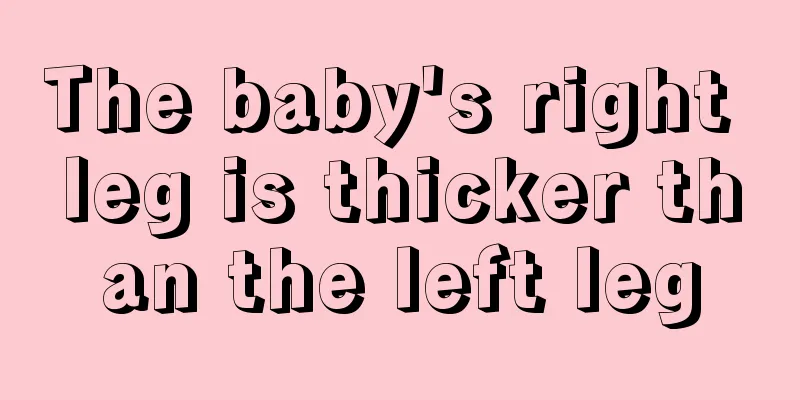The baby's right leg is thicker than the left leg

|
After a child is born, he or she needs careful care from his or her parents, and the baby's growth should be carefully observed. Some parents may find that the baby's right leg is thicker than the left leg. Why is this? In this case, you need to go to the hospital for a check-up to see if you have symptoms of congenital hip dislocation. This is a relatively important examination. Once the problem is discovered, the younger the age, the more obvious the treatment effect will be and the faster the recovery will be. 1. Why is the baby's right leg thicker than the left leg? It is best to go to the hospital for a check-up to rule out whether it is congenital hip dislocation. Don't worry too much about this problem and take appropriate treatment measures based on the examination results. Ensure the healthy growth of children. Treatment of congenital dislocation of the hip 1. Conservative treatment The theoretical basis of conservative treatment is Harris's law, which states that head and acetabulum concentricity is the basic condition for hip joint development. In order to achieve stability of the hip joint after reduction, the following conditions must be met: ① Choose a posture that maintains hip joint stability. The traditional frog position is the most ideal posture, but it is not conducive to blood supply to the femoral head. ② Choose a brace, splint or plaster fixation according to the different ages of the patients. It should be stable, comfortable, convenient, and easy to manage urine and stool. It is best to keep the hip joint properly active. ③ Choose the most suitable age for hip joint development. The younger the better, generally under 3 years old. ④ The head and acetabulum should be proportional. If the proportion is unbalanced, the stability of the hip joint cannot be maintained, and even treatment failure may occur. ⑤ Maintain reduction for a certain period of time to allow the joint capsule to shrink back to nearly normal and prevent dislocation after the fixation is removed. It usually takes 3 to 6 months. The younger the patient is, the shorter the fixation time will be. 2. Surgery (1) Salter pelvic osteotomy In addition to repositioning the femoral head, the Salter operation mainly changes the abnormal acetabulum direction to a normal physiological direction, relatively increases the acetabulum depth, and makes the femoral head and acetabulum concentric. This surgery can be used for patients aged 1 to 6 years with hip dislocation, including those who have failed manual reduction. (2) Pemberton acetabuloplasty is a procedure that involves osteotomy 1 to 1.5 cm above the superior rim of the acetabulum parallel to the acetabular roof slope, prying the acetabular end upward and changing the inclination of the acetabular roof, allowing the acetabulum to fully encompass the femoral head and allowing the acetabulum to achieve a normal shape. This procedure can be used for patients over 7 years old or under 6 years old with an acetabular index greater than 46°. (3) Femoral rotation osteotomy and femoral shortening osteotomy Femoral rotation osteotomy is suitable for patients with an anteversion angle of 45° to 60° or more and should be performed at the same time as the above-mentioned surgery. Generally, osteotomy is performed below the lesser trochanter, usually with a wire saw. After osteotomy, the proximal osteotomy end is internally rotated or the distal osteotomy end is externally rotated and fixed with a 4-hole steel plate, but care should be taken not to over-correct. Femoral shortening osteotomy is suitable for older patients with grade III dislocation, especially those with inadequate traction before surgery. Osteotomy is also performed under the lesser trochanter, shortening the femur by about 2 cm. It can also correct excessive anteversion at the same time, and then fix it with a 4-hole steel plate. |
<<: What should I pay attention to when my child has watery beans?
>>: 8 month old baby suddenly refuses to eat complementary food
Recommend
24 month old baby not talking
Generally, babies over two years old can speak so...
What is precocious puberty? Causes of Precocious Puberty
Precocious puberty is a topic that the society is...
Children eat dragon fruit and their urine turns red
The nutritional value of pitaya is very high. It ...
What is the cause of early puberty in children caused by bird's nest?
Children are a relatively special group, because ...
What is the reason for the child's convulsions?
Convulsions in children are a very common pediatr...
Reasons for spitting up milk in a two-month-old baby
It is very normal for a baby of half a month to s...
Vulva redness and itching in infants
Generally speaking, the vulva of young children i...
What are the symptoms of milk allergy in babies?
It is inevitable for babies to drink milk during ...
Depressed skull fractures in children
Compared with adults, babies' skulls are more...
How to deal with cold hands and feet after the child's fever subsides
When a child has a serious fever, parents will gi...
At what age do children usually start to speak? At what age is it normal for children to speak?
From the moment they are born, children develop a...
It is harmful for children to have hard lumps of earwax
In fact, the ears also have secretions. Although ...
What are the reasons why children lie?
For children, lying can be divided into two categ...
Is it normal for a 10-year-old girl to start developing breasts?
Now everyone's life is getting better and bet...
Symptoms of a fish bone stuck in the baby
There are many benefits to babies' health whe...









